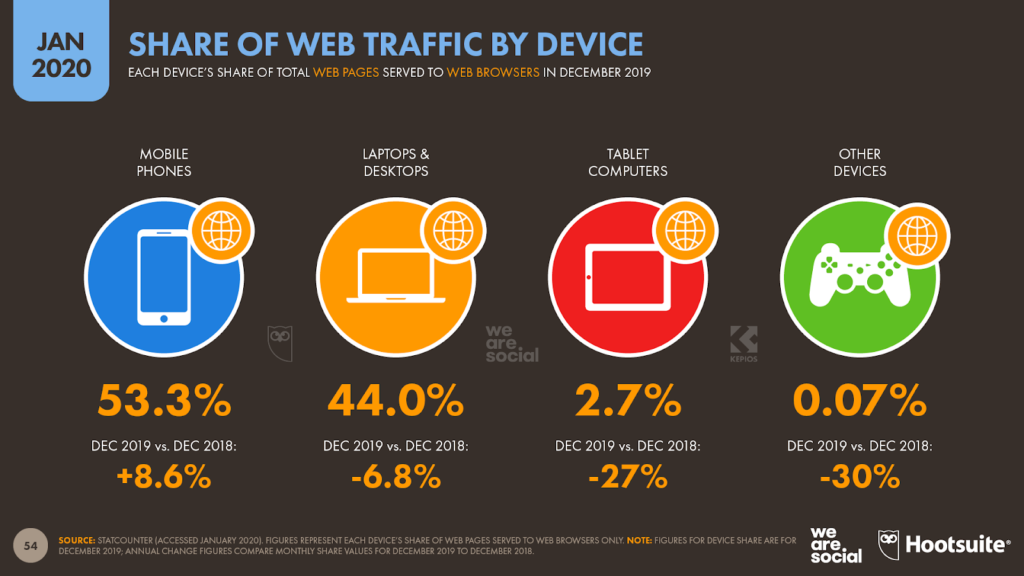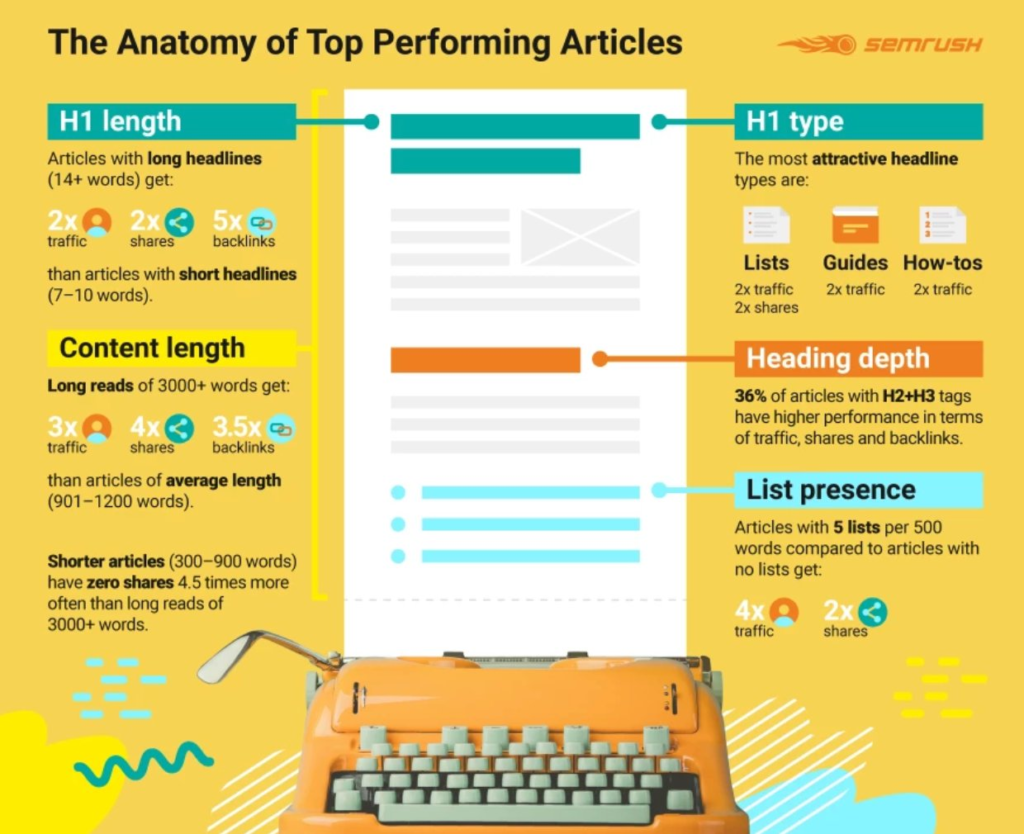25 Content Marketing Statistics to Help Build Your Strategy: The 2022 Edition

Table of Contents
- Top Content Marketing Statistics
- Key Takeaways
- Conclusion
- FAQs
It’s that time of the year again. The financial year is ending, and before another one begins, we must start planning well for allocating our marketing budget. Most budget decisions are based on learnings from the previous year. And while that is correct, sometimes, an external perspective helps make a much better decision. This can be obtained by looking at relevant content marketing statistics.
These statistics are helpful because they help in feeling the pulse of general content marketing trends that can be useful for building a content marketing strategy. You can have a powerful and targeted content marketing strategy using a combination of personally collected data and global statistics.
Top Content Marketing Statistics
1. 91% of B2B marketers use content marketing
Content marketing plays a vital role in business-to-business companies, especially startups. When companies have finally developed a viable product that can be sold in the market, they need to reach the right audience. This can be made possible in two ways: spend a lot to hire a large marketing team or use content marketing.
Many businesses rely on the latter because it is much easier to reach a large audience and make initial sales through content marketing platforms. Of course, content marketers add more value to these platforms once they are brought on board. All in all, the combined efforts almost always prove useful. This is why this statistic is that significant. In fact, the original researcher of this statistic, Demand Metric, has also mentioned that 81% of B2C marketers use content marketing.

2. We are spending around 7 hours per day consuming online media.
Double Verify conducted this research, showing just how much time humans are now spending online. That is approximately 30% of the 24 hours we receive in a day to conduct all our business.
This research is particularly interesting because this sounds like an incredibly lucrative opportunity for businesses (both B2B and B2C). They can capitalize on the fact that people spend so much time online. The pandemic and almost 2.5 years of lockdowns worldwide have only contributed more to this statistic.
3. SEO is capable of driving 1000%+ more traffic than organic social media
According to BrightEdge, most businesses in their survey sample have revealed that SEO is a key factor in getting organic traffic to one’s website. SEO is definitely one of the simplest ways to get organic traffic, especially when you have no other marketing campaigns. It requires a bit of technical knowledge, which many courses offer.

4. Landing pages have the highest conversion rate at 24%
Despite being the least popular type of signup form because of just how much effort goes into setting up a landing page, this marketing collateral can get a high conversion rate of 24%. This means that sometimes some marketing plans can take a lot of resources to implement, but those efforts mean something in the end if you get a high number of leads.
5. Popups have the second-lowest conversion rate at 4%
On that note, despite being the most popular type of signup form, pop-ups have the second-lowest conversion rate at 4%. This is understandable because users generally tend to find pop-ups annoying. Pop-ups distract users from what they are paying attention to at that moment and can be pretty invasive. If you’re thinking of using popups, maybe it is time to reconsider.
6. ECommerce sales in global B2C reached approximately $4.5 trillion in 2021
Shopify estimates that this is the age of eCommerce sales. Consumers rely on the ease of access while shopping as it helps them save time. Consumers love shopping online because they get to read reviews, avoid commutes, get discounts, among other advantages. It’s no wonder eCommerce is expanding at such a high pace.

7. Google products have a stake in about 94% of Internet searches.
This research was conducted by JumpShot, which estimated that most Internet searches are being performed on Google properties. This includes Google Chrome, Google search, among others. Google is definitely a tech giant wherein it dominates the Internet world. Content marketers need to consider the behemoth that Google is in their content marketing strategies.
8. Around 45% of millennials in the US use voice-search during online shopping.
Millennials in the US are making use of technology in their everyday lives. In fact, many of them are working from home, which shows that without the Internet, their professional lives will take a hit. This is why so many millennials are using voice-search—out of convenience more than anything else, as reported by Statista.

9. 200% growth in the last two years in “where to buy” and “near me” mobile queries
Google reported in 2019 that consumers are populating Google searches with the queries listed above. Gone are the days when people would go to a particular location and ask around for a specific service. Today people are actively searching online for things near them. For marketers, it means that they should start working on content that uses local search words and terms.
10. Around 24% of US adults own a Smart Speaker (60 million people)
The Smart Audio Report found out that people increasingly use voice searches out of convenience. This is the sole reason why there has been an uptick in the number of smart speakers. Marketers need to rethink their content marketing strategy and start focusing on voice searches to increase relevant content. Perhaps a starting point could be creating a database of voice searches and publishing content on that.
11. Mobile devices generated half of all website traffic as of 2019
Statista found out in 2020 that users prefer mobile devices (excluding tablets) to use the Internet. Content marketers need to take this statistic seriously and optimize their websites and other marketing content for small screens. Additionally, while designing ads to run on most websites, opting for a responsive design will help make sure that no technical errors occur while a user is carrying out a session on a website. Perhaps taking a mobile-first approach should do the trick as a starting point.

12. WordPress users publish 70 million posts each month.
WordPress is definitely the world’s most popular content management system, and many bloggers have made a living out of publishing a blog on WordPress. In their research, WordPress found out that their users publish 70 million posts each month and 77 million new comments every month as well.
Content marketers need to learn how to become a part of this community and make the most out of knowing how to advertise or use WordPress for their own blogging requirements.
13. Blogs are one of the top three forms of media used by content marketers.
According to HubSpot’s research, out of the three most popular media forms used by content marketers, blogs play a significant role. For a new organization especially, a blog is an important first step. It’s the best place to interact with a new audience. Setting up a blog and writing consistently can help you reach a wide audience and build a community. It’s also rewarding because you can run ads on your blog or paid partnerships. Through this, you can also earn money in the process.
14. A whopping 18% of content marketers rely on WordPress as their CMS
HubSpot found out in 2020 that despite WordPress being the world’s most popular content management system, only 18% of content marketers are using it. It’s time that content marketers rethink their CMS as clearly people are migrating to other CMS and leaving WordPress behind.
15. Almost all industries depend on “Search” to drive major traffic.
SEMRush, one of the world’s top SEO tools, conducted research to ascertain that most industries rely on Search to drive their traffic. This makes sense considering not every organization has the budget to spend on paid ads.
16. Long-form articles (3000+ words) get 3x more traffic, 3.5x more backlinks, and 4x more shares.
SEMRush also found out recently that long-form articles are preferred over short posts. This is one primary reason why one can see most blog posts trying to hit a minimum of 2000-3000 words. Apparently, web users are more interested in reading content in detail than just introductory content. It’s about time marketers start focusing on long-form content resources.

17. Google’s search algorithms give preference to visual and audio media over text.
More and more people are using audio and visual media such as YouTube videos and podcasts to get their queries answered. Google has identified that pattern, and now its algorithms are giving preferential treatment to audio and visual media over text. Content marketers need to start rethinking the content they are producing based on this information.
18. 86% of companies rely on blogs more than other content formats
In 2019, SEMRush’s report showed just how much companies rely on blogs as a primary content marketing strategy. Blogs are easy to set up, with total costs ranging between $20-$50. They require just some initial design, and optimizations can be made every 6 months. This information just shows how lucrative setting up a blog is. It means that you can get a high amount of organic traffic with minimal effort. That sounds like a win!
19. 38% of marketers will use infographics in 2022
Hubspot has predicted that there will be an increase in the number of infographics that content marketers tend to put on their websites in 2022. This is another great statistic as it means marketers are willing to experiment beyond just text. Creating infographics may take time, but visual media almost always performs better than text.
20. 80% of video marketers believe video has directly driven sales
In 2020, Wyozwl found out that content marketers believe video has directly been responsible for enhancing sales. This barely comes as a surprise considering just how much video content we consume nowadays.
21. LinkedIn is among the top platforms to distribute content for 91% of B2B marketers.
LinkedIn has a lot of potential for B2B marketers as it’s the best place to connect with other like-minded professionals in your industry. And the above statistic shows that many B2B professionals also realize the same. LinkedIn has also rewarded them with marketing opportunities such as inMail ads and native ads.

22. Around 60% of content marketers repurpose existing content 2-5 times.
According to LookBookHQ, content marketers are frequently repurposing their existing content and converting them into snackable formats. This pretty much makes sense because sometimes it’s hard to get resources to create new content. However, repurposing old content in the form of social posts or short blogs can do the trick.
23. 60% of content marketers create at least 1 content write-up every day
According to eMarketer, content marketers are at their most prolific in the current era. Since content is an important aspect of digital marketing, it’s no surprise that 60% of marketers create at least 1 content piece per day. More content pieces translate to more publishing opportunities, which is always a good thing.
24. Almost all email service providers have around a 79.6% deliverability rate.
If you have delved into email marketing, you know how frustrating this can be. You are doing the best you can: optimizing your emails, changing your email service provider, etc. But the email deliverability score refuses to go up. Fret not, as you are definitely not alone.
According to EmailToolTester, almost all email service providers offer only around a 79.6% deliverability rate which means that there is a high chance your email never reaches the right person or ends up in spam. The only thing you can do is make your email content as less spammy as possible.

25. At least 50 unread emails are in the inboxes of 40% of consumers (Sinch, 2020)
According to Sinch’s Mobile Consumer Engagement 2020 report, almost half the population with an email address has at least 50 unread emails. This statistic is alarming because it shows how important it is to optimize your emails or newsletters while trying to scale email marketing. Important aspects like subject lines, email body, email deliverability, etc., play an important part in ensuring that your emails do not remain unread. Moreover, businesses also need to find a balance between sending the right number of emails and spamming.
Key Takeaways
- Most of the budget decisions are based on learnings from the previous year. And while that is correct, sometimes an external perspective helps make a much better decision.
- Using a combination of personally collected data and global statistics, you can have a powerful and targeted content marketing strategy.
- SEO is definitely one of the simplest ways to start getting organic traffic, especially when you have no other marketing campaigns going on
- Pop-ups distract users from what they are paying attention to at the moment and can be pretty invasive.
- Hubspot has predicted for 2022 that there will be an increase in the number of infographics that content marketers tend to put on their websites.
Conclusion
We hope these content marketing statistics help you curate a marketing strategy that proves useful in earning high revenue. If you are unsure how to start using these statistics, try to compare a statistic with your own performance. For example, are you repurposing content 2-5 times like 60% of other marketers? If the answer is no, maybe you can try accommodating that into your strategy.

FAQs
These statistics are helpful because they help in feeling the pulse of general content marketing trends that can be useful for building a content marketing strategy.
Because through content marketing, they can reach a large audience with less budget spent than what it could have taken them to hire a marketing team.
According to EmailToolTester, almost all email service providers offer only around a 79.6% deliverability rate, which means that there is a high chance your email never reaches the right person or ends up in spam. The only thing you can do is make your email content as less spammy as possible.
Pop-ups distract users from what they are paying attention to at the moment and can be quite invasive. If you’re thinking of using popups, maybe it is time to reconsider.
LinkedIn has a lot of potential for B2B marketers as it’s the best place to connect with other like-minded professionals in your industry. It provides services such as native ads, inmail ads, groups, etc., which helps businesses increase their popularity.
Latest Blogs
Explore how Google’s 2025 AI search updates triggered ranking chaos. Learn actionable strategies to adapt your SEO for AI Overviews, zero-click searches, and SERP volatility. Stay ahead now.
Learn how to rank on AI search engines like ChatGPT, Perplexity, and Gemini by optimizing your content for authority, structure, and relevance. Stay ahead in AI-driven search with this strategic guide.
Explore the best healthcare SEO services for your medical practice. Improve online visibility and effectively reach more patients in need of your services.
Get your hands on the latest news!
Similar Posts

Content Marketing
4 mins read
11 Best B2B Content Marketing Agencies for B2B Companies in 2024

Content Marketing
5 mins read
Top ecommerce Marketing Agencies with Proven Strategies for 2024

Content Marketing
5 mins read